Operator panels for use with controllers
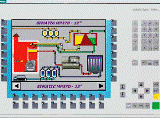 To enable convenient human interaction with the automation system, an operator panel is used, which is an input-output device for information and thus is the main means of human-machine interaction. The operator panel is often connected to one or more controllers, which is not uncommon in various industries.
To enable convenient human interaction with the automation system, an operator panel is used, which is an input-output device for information and thus is the main means of human-machine interaction. The operator panel is often connected to one or more controllers, which is not uncommon in various industries.
The operator's panel is programmed specifically for the controlled equipment, so the operator can easily select the system's operating mode, enter equipment control parameters, monitor the work flow and receive information about both the current system status and previous ones states (data can be saved).
In addition, the operator panel allows you to identify an accident or malfunction in time. The controller connected to the panel performs automatic control by being connected to the panel through a modern interface.
Thus, operator panels find the widest application in industry, in the field of medicine, in automated building management systems, etc.
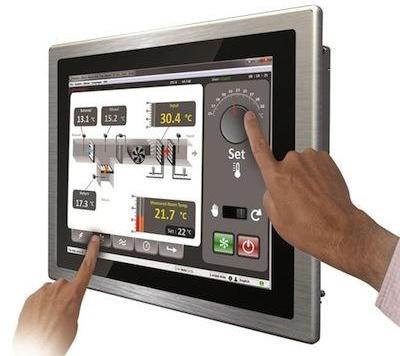
Thanks to operator panels, there is no need to install a large number of control and signaling equipment, as is traditionally the case in conventional automation systems.
The panel and controllers of automatic technological process control systems (APCS) are connected by interface cables, and the display shows in virtual form signaling and control elements, mnemonic diagrams, in general, everything that is included in the functionality of a particular device (panel).
The operator panel eliminates the need to install a large number of buttons, indicators, switches, displays and takes up very little space, resulting in a kind of multi-functional operator panel.
The operator panel can be easily placed in a convenient location, whether it is a control panel, a cabinet door where controlled equipment is installed, or an existing panel of an automated process control system. At the same time, the panel has a sufficient IP protection class.
These are the basic building blocks of a typical operator panel:
-
A display that can be graphic, text or text-graphic;
-
An input device, which can be a keyboard, touch screen or joystick;
-
Memory, RAM and Flash, for example in the form of a memory card;
-
Some models have a built-in programmable logic controller;
-
Interfaces for communication with external controllers and for programming;
-
The kit includes specialized software.
Today on the market of operator panels there is a large selection of devices with different designs, but they can be divided into the following types:
-
Graphical operator panels;
-
Operator panels are touch sensitive;
-
Text-graphic operator panels with keyboard;
-
Operator panels are touch sensitive logically.
Graphics and text-graphics panels equipped with a keyboard have a set of buttons, for each of which a functional purpose is assigned and a group of corresponding screens is created. Charts and graphs can be displayed here. For industrial automation purposes, graphical and text-graphical operator panels are what you need.
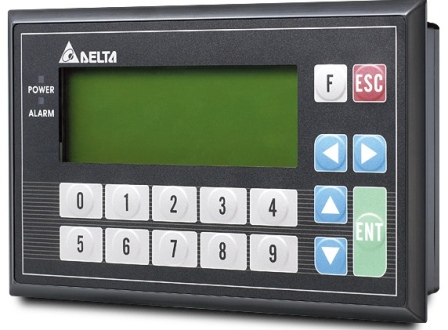
An example is the text-graphic operator panel model TP04P from Delta Electronics. It is equipped with a membrane keyboard, has a monochrome LCD display and is controlled by a built-in PLC. Up to 32 inputs and outputs are supported.
The menu is multilingual, has a real-time clock and, of course, communication ports… The different configurations of the outputs and inputs of the panel make several different modifications to it:
-
TP04P-16TP1R: 8 digital inputs, 8 digital outputs;
-
TP04P-32TP1R: 16 digital inputs, 16 digital outputs;
-
TP04P-22XA1R: 8 digital inputs, 8 digital outputs, 4 analog inputs, 2 analog outputs;
-
TP04P-21EX1R: 8 digital inputs, 8 digital outputs, 2 analog inputs, 1 analog output, 2 inputs for signals from temperature sensors.
Since the PLC built into the panel has an SS2 core, it is possible to connect outputs and inputs for different purposes. There are indicators for the status of the outputs and inputs. The keyboard is programmed according to the needs of a specific production. The software is downloaded to the panel and via the USB port. It has several RS485 ports.
Today, these panels are actively used in utilities, industry and other areas where automation and control are required.The combination of a panel with a PLC makes this panel not only economically accessible, but also quite a pragmatic solution, it takes up little space, is easy to install and is unpretentious in operation. The software is available on the manufacturer's official website. Using a special memory card TP-PCC01, you can copy software from one panel to another.
A great opportunity for creativity in the design of an automated process control system is provided by the operator's touch panels. Here, in contrast to text-graphic and graphic panels, unique graphic elements and screens with sets of all kinds of elements are offered. The user can load his own graphics, and control is done through the touch matrix on the screen itself, which responds to touch.
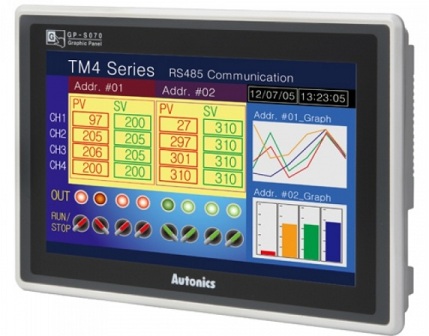
An example of touch screen operator panels is the GP-S070 series from Autonics. These are truly state-of-the-art means of implementing a human-machine interface with support not only for USB, but also for RS422, RS232 and Ethernet to exchange and collect data from external barcode scanners, PLCs, printers, with subsequent display on an LCD screen with TFT matrix...
The series includes two modifications: GP-S070-T9D6 and GP-S070-T9D7. The first has one RS422 and RS232 port and the second has a pair of RS232. The display is flawlessly easy on the eyes, with the possibility of easy touch control. Many fonts and image libraries are supported.
The USB Host and USB Device ports are used for downloading and managing files. For communication with external devices — RS422, RS232 and Ethernet. There is also an option to log data. Fresh software is always available on the official website of the developer. To control the connected PLCs and monitor their parameters, the PLC port is intended.Any language display settings are possible. User can independently develop software using GP Editor.
Today, GP-S070 series panels can be found in a variety of industries where they are used for control and dispatch, as well as in other areas, particularly residential and utility. These terminals simplify complex automated process control systems and facilitate their implementation.
Operators' touch screen logic panels have a built-in PLC, which allows for further expansion of the possibilities of designing an automated process control system, because here you can create and visualize a program and all in one device.
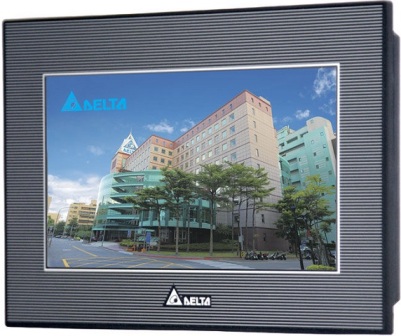
An example of a touch logic panel is the TP70P from Delta Electronics. This panel has a built-in logic controller and is designed to work in modern automated control systems. By combining a color touch display with an integrated PLC, a wide range of functions is possible, far beyond those of standard operator panels.
The ability to connect various external devices allows you to design control systems for servo drives, temperature sensors and implement many other projects based on the TP70P in almost any industry and economy.
The TP70P series includes four modifications with a difference in the number and type of outputs and inputs, as well as an additional fifth modification RM0 with an extension in the form of an RS-485 interface. The specific model is selected according to the user's requirements, based on the set of externally connected equipment.
The 800×400 full-color TFT touch screen can display over 60,000 shades for the clearest information visualization, can be graphs, charts, distance counters and indicators.
The software is loaded into the panel via the USB port. Temperature sensors are connected directly to the panel. All inputs are high speed. The built-in PLC supports programs up to 8000 steps long and can store up to 5000 words. The PLC is equipped with an individual communication port.
In fact, the developer is in the hands of a full-fledged tool for managing not only simple machines, but also complex automatic systems and control and measurement equipment. The panel is suitable not only for enterprises, but also for the implementation of smart home systems.
